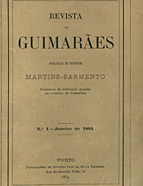

................................
In the former case, this cultural promotion combined erudition and critical analysis of sources with a potentially patrimonialist perspective, whereas in the latter, there was a shift towards university specialisation, often at the expense of panegyrics, albeit discreet ones. Notable figures include Alberto Balil, Firmin Bouza Brey, and Júlio Caro Baroja, among many others. The Revista de Guimarães has, over time, been organised into several sections: articles, chronicles of events, bibliographical , the Martins Sarmento Society Bulletin , conferences held at the society, as well as balance sheets and budgets . The Revista de Guimarães is regarded as a publication of interest to history , according to José Maria Amado Mendes. He reserves the designation of a speciality periodical for the late 19th century and the early decades of the 20th century to O Arquivo Histórico Português, A Revista de História [The Portuguese Historical Archive, The Journal of History] and Revista de Estudos Históricos [Journal of Historical Studies] (J. A. Mendes, Idem, p. 212). However, classifying the nature of the Guimarães periodical is highly complex, and it can be seen as an approximation to the concept of the speciality press . Primary sources, such as the Colegiada or the Estatutos dos Ofícios , featured prominently in the pages of the Revista , with a strong emphasis on local and archaeological aspects. In 1973, the Martins Sarmento Society and the Revista de Guimarães faced a challenging period when their director, Mário Cardoso, had to step down due to health reasons. This circumstance led to the publication of a short note by Augusto Ferreira da Cunha, the incumbent vice president, in which he briefly recounted the entire history of the periodical from its inception. He also praised the transformative role of Eduardo de Almeida from 1921 onwards (CUNHA, Augusto Ferreira da, Nótula [Short Note] , vol 83, 1973, pp. 5-6). In the final months of 1974 and throughout 1975, references to the acceptance (or lack thereof) of the 25 April Revolution were virtually absent from the meetings of the Martins Sarmento Society. This silence may have been due to the recentness of the events but also likely stemmed from ideological and other factors related to the nature of the Revista de Guimarães . In 1989, the Boletim de Actividades [Activities Bulletin] of the Martins Sarmento Society was reduced to a minimal expression and informative dimension, limited mainly to the election of new governing bodies. As far as articles are concerned, in the first ten years, the Revista de Guimarães published 67 new studies. Archaeology was the field most frequently chosen by scholars. Between 1894 and 1903, there was a significant reduction in the number of articles (40) and a partial change in the thematic profile. Archaeology lost its prominence.
This work is financed by national funds through FCT - Foundation for Science and Technology, I.P, in the scope of the projects UIDB/04311/2020 and UIDP/04311/2020.
